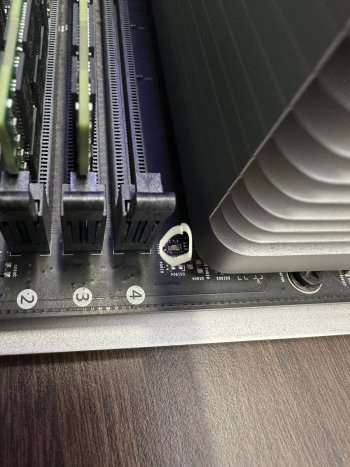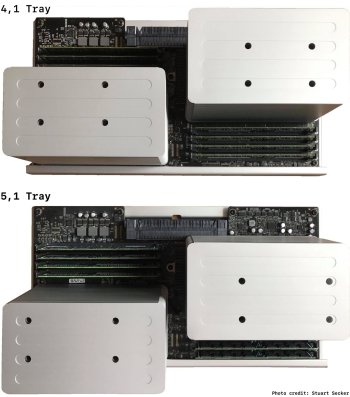I have a 2009 Mac Pro I have been upgrading for video editing. I’ve replaced the dual CPU’s, graphics card etc. Everything was working fine until it decided not to boot up. Power light is on but no boot chime. I suspect the motherboard because heat sinks are not heating. There is a red led that flashes briefly. I took a picture of the led that flashes. Anyone have any suggestions. I’m not a computer expert so any suggestions would be appreciated.
Got a tip for us?
Let us know
Become a MacRumors Supporter for $50/year with no ads, ability to filter front page stories, and private forums.
MP 1,1-5,1 2009 Mac Pro no chime
- Thread starter Skbusta
- Start date
- Sort by reaction score
You are using an out of date browser. It may not display this or other websites correctly.
You should upgrade or use an alternative browser.
You should upgrade or use an alternative browser.
There are loads of threads here from previous users that you can get more info and help on how to diagnose your Mac Pro via DIAG leds, no need to rewrite here, but in the end the only shortcut is to test your CPU tray with a known working Mac Pro and a known working CPU tray with your defective one.
Don't get me wrong, but Mac Pros are extremely difficult to diagnose for people without experience/knowledge and practically impossible without a test mule. Test your parts with a known working Mac Pro to identify what really failed.
Don't forget to also test the PSU.
Don't get me wrong, but Mac Pros are extremely difficult to diagnose for people without experience/knowledge and practically impossible without a test mule. Test your parts with a known working Mac Pro to identify what really failed.
Don't forget to also test the PSU.
@Skbusta. Probably the better route is get a second, working 2009 Mac Pro to narrow down the issue like what Tsialex suggested. A few years ago, my Mac Pro, suddenly would not boot, no chime at all. Luckily, I had another working Mac Pro to test out. Found out the issue and the only a minor problem, one of the ram stick was not compatible with the other group of ram sticks. Took out the incompatible ram and all was good, the Mac Pro booted fine. If I didn’t have a second Mac Pro as a test mule, I probably would go nuts guessing if it might be the cpu tray, the logic board? The PSU or GPU? Northbridge?
I can probably post the problem in this forum but if the issue is hardware related, might be a long shot figuring out it was only a case of incompatible ram. There’s that communication limitation in figuring out the problem without the onsite examination. Just one note, don't get a 2010 Mac Pro to test with your 2009 Mac Pro. Their components are not compatible.
I can probably post the problem in this forum but if the issue is hardware related, might be a long shot figuring out it was only a case of incompatible ram. There’s that communication limitation in figuring out the problem without the onsite examination. Just one note, don't get a 2010 Mac Pro to test with your 2009 Mac Pro. Their components are not compatible.
Just one note, don't get a 2010 Mac Pro to test with your 2009 Mac Pro. Their components are not compatible.
You can test an early-2009 component with a mid-2010/mid-2012 Mac Pro and vice versa.
The issue is that the early 2009 backplane and CPU trays have the SMC microcontroller programmed at the factory with SMC firmware version 1.39f5 while the mid-2010/mid-2012 have it at version 1.39f11, these two versions are incompatible with each other and when you install an early-2009 CPU tray to a mid-2010/mid-2012 (or vice-versa) the SMC from the backplane can't talk with the CPU-tray SMC, the mismatch will make the SMC enter fail-safe mode and run all fans at full speed, but that is not a problem for testing parts.
You can't upgrade the SMC of the early-2009, can't be dumped and the 1.39f11 SMC firmware never leaked from Apple.
Everything else inside the case is completely compatible, you can use every other component as replacement parts or to test without any adverse effect. For example, you can install an early-2009 PSU to a mid-2012 Mac Pro, no problem.
Thanks for clarifying. Just to add, another way to check if the CPU tray is a 2009 4,1 or 2010/2012 5,1 is the distance of the four holes on the heatsinks. The 2009 CPU tray has the 4 holes closer to each other. The 2010/2012 cpu tray has the holes farther apart. With the other 2 holes closer to the edge of the heatsink. I saw some CPU trays being sold online that are misdeclared by the seller. Like a 2009 tray being passed on as 2010/2012 or the other way around.You can test an early-2009 component with a mid-2010/mid-2012 Mac Pro and vice versa.
The issue is that the early 2009 backplane and CPU trays have the SMC microcontroller programmed at the factory with SMC firmware version 1.39f5 while the mid-2010/mid-2012 have it at version 1.39f11, these two versions are incompatible with each other and when you install an early-2009 CPU tray to a mid-2010/mid-2012 (or vice-versa) the SMC from the backplane can't talk with the CPU-tray SMC, the mismatch will make the SMC enter fail-safe mode and run all fans at full speed, but that is not a problem for testing parts.
You can't upgrade the SMC of the early-2009, can't be dumped and the 1.39f11 SMC firmware never leaked from Apple.
Everything else inside the case is completely compatible, you can use every other component as replacement parts or to test without any adverse effect. For example, you can install an early-2009 PSU to a mid-2012 Mac Pro, no problem.

The Definitive Classic Mac Pro (2006-2012) Upgrade Guide
The largest/most-complete guide to all possible classic Mac Pro upgrades covering OS, Firmware, GPU, CPU, Storage, USB, THunderbolt and Network upgrades.
Attachments
Thanks for clarifying. Just to add, another way to check if the CPU tray is a 2009 4,1 or 2010/2012 5,1 is the distance of the four holes on the heatsinks. The 2009 CPU tray has the 4 holes closer to each other. The 2010/2012 cpu tray has the holes farther apart. With the other 2 holes closer to the edge of the heatsink. I saw some CPU trays being sold online that are misdeclared by the seller. Like a 2009 tray being passed on as 2010/2012 or the other way around.

The Definitive Classic Mac Pro (2006-2012) Upgrade Guide
The largest/most-complete guide to all possible classic Mac Pro upgrades covering OS, Firmware, GPU, CPU, Storage, USB, THunderbolt and Network upgrades.blog.greggant.com
Yes, but this is valid just for the dual CPU tray.
For single CPU trays, it's a lot more complicated, you can't even be sure that the part number silk-screened to the PCB is 100% safe, since Apple re-flashed mid-2010s CPU trays with 1.39f5 for early-2009 CPU tray repairs.
It's rare but some people here have these refurbished mid-2010 CPU trays re-flashed with 1.39f5 firmware version.
If the single CPU tray serial number label have a 17-digits serial number, all factory refurbished CPU trays and backplanes after the year 2010 have a 17-digits serial number, the only way to be 100% sure is powering it up and checking the SMC firmware version.
Yep, I was only referring to the dual processor tray. For single processor trays, it’s a different scenario. A client of mine sought my help to purchase a 2010 dual processor tray. I encountered a seller from Facebook who was selling a 2010 dual processor trays but he could not provide a screenshot of the smc firmware if it is 1.39f11. The seller no longer has the complete Mac Pro computer as he sold them as individual parts. That was when I had to verify with the seller the actual photo of the tray to double check. And to be on the side of caution, I requested the seller to agree that I can return the processor tray in case of problems. ThanksYes, but this is valid just for the dual CPU tray.
For single CPU trays, it's a lot more complicated, you can't even be sure that the part number silk-screened to the PCB is 100% safe, since Apple re-flashed mid-2010s CPU trays with 1.39f5 for early-2009 CPU tray repairs.
It's rare but some people here have these refurbished mid-2010 CPU trays re-flashed with 1.39f5 firmware version.
If the single CPU tray serial number label have a 17-digits serial number, all factory refurbished CPU trays and backplanes after the year 2010 have a 17-digits serial number, the only way to be 100% sure is powering it up and checking the SMC firmware version.
Thanks for all the great advice. I ordered some cheap CPU’s off EBay and honestly I’m pretty confident that’s the issue. They were supposed to be Intel x5690’s but since I bought them de-lidded I didn’t really check if they were authentic. Fortunately I was still in the the return window on EBay and ordered new CPU’s from a more reputable company. When I requested a refund the company didn’t question it. So my guess is they worked for about a week and then went out. I’m waiting for the new ones to come in to test my theory. I would put the old ones in to test it but since I flashed the firmware and am running Mojave I don’t think they will work. Let me know what you guys think.
I would put the old ones in to test it but since I flashed the firmware and am running Mojave I don’t think they will work. Let me know what you guys think.
Nothing changes with processor support with Mojave and upgraded firmwares, you can go back to the factory Xeons anytime.
Well my CPU’s came in today and I put them and still not booting. I even put the original Xeons back in as suggested but still nothing. I’m really disappointed and discouraged. I really don’t want to buy another Mac Pro to swap out parts and I’m thinking about returning the the parts that I can and scrapping the whole project. Does anyone have any recommendations for another Mac that might be able to handle editing FHD video. I’m already in the hole on this project almost a grand. I thought this would be a “budget” project because I already had the computer. But I really need this to work because I’m not working right now and I’m putting all my energy into getting my video production company started. Sorry for the long post but I’m at the end of my rope here and just kind of venting. Thanks for everyone’s help.
Register on MacRumors! This sidebar will go away, and you'll see fewer ads.



